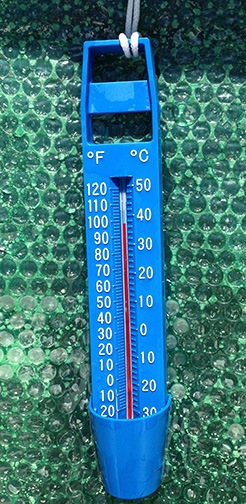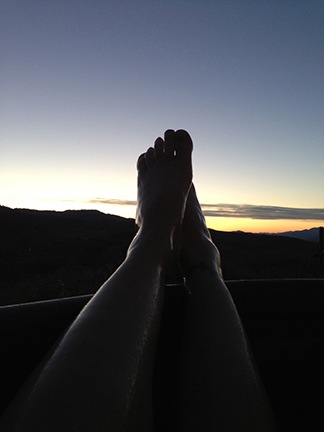Dear Julia,
I was saddened — but not terribly surprised — to learn of your passing early this morning. After all, you’d reached that 90-year milestone and your health had never been very good throughout the 30 years I knew you. Both Mike and I were continuously surprised at your long life. “My mother is a force of nature,” he used to say.
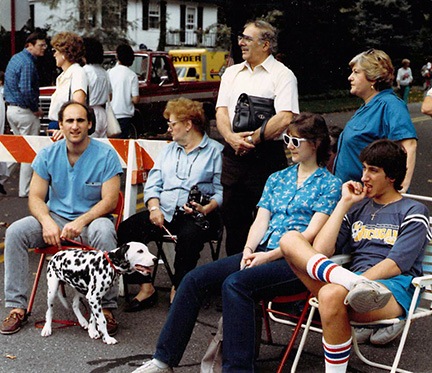
Do you remember this day, Julia? I think it was Memorial Day, perhaps the first year Mike and I lived in New Jersey. You and Charlie were there, along with my family, watching the parade at the end of our street. It was so long ago — Mike almost had hair!
As I think back on all those years — the first twelve or so while your husband was still alive, and the later years when you were left without him — my mind recalls various scenes in which you were a player. In the beginning, you were a minor character, but over time you took on a more starring role.
I often think of the night your husband died so suddenly. Of getting that terrible phone call in the middle of the night — the one no one wants to get — and being at the wheel of Mike’s car with him sitting in stunned disbelief beside me as we sped the 30 miles from our home to yours. Of seeing the New York City police officers milling about your living room. Of seeing your husband Charlie laid out so peacefully on a bed in the spare room with a blanket up to his chest as if he were just sleeping. Of the shock you must have felt looking at your dead husband while the space he’d occupied beside you in bed only a short time before was still warm from his body and love for you. That morning was incredible, fixed upon my mind like an etching in stone. You were so unprepared for his death. One evening, you’re having dinner with him and 14 hours later, you’re shopping for his casket and cemetery plot. I honestly don’t know how you did it. You showed a strength that day that I know I don’t have. But I suspect that in private you were far more tearful than I am right now, just recalling and writing about it. (Yes, the tears are running down my face now as they have so many times in the past year when I think back to things that once were.)
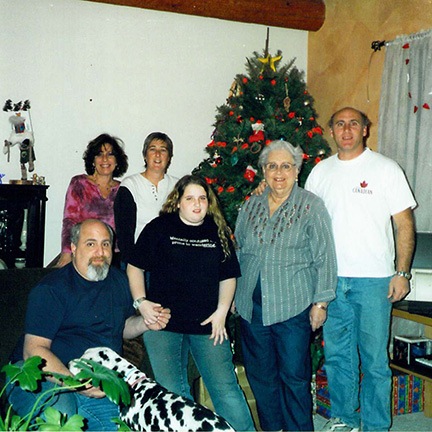
Your family’s visit to our home at Christmas in 2005 was a bit trying, but not because of you.
Charlie’s death didn’t just change your life — it changed ours. It changed Mike’s role, forcing him to fill your husband’s shoes in caring for you. Charlie took such good care of you, handling all the little chores of life, that you could not manage so many basic things on your own. I clearly recall Mike and I teaching you how to write checks and balance your bank accounts. And the “honey do” lists you had for Mike! They were a bit of a joke — at least at first — and expected on every visit to your home. I have a clear image of you consulting a scrap of paper as Mike finished a task and asked you what was next. Oh, how he dreaded visiting right after the beginning or end of daylight savings time! All those clocks!
But Mike stepped up to the plate and did so many things for you — often without your knowledge. I did a few, too, but admittedly not as many as I could or should have.

I was really proud of you the day you climbed into Mike’s plane with him. I didn’t think you could do it; I should have known better.
Indeed, Mike was “the good son” and you wanted me to be the good daughter-in-law. How I must have frustrated you! The engagement in 1984 should have been followed by a wedding soon after, but I just couldn’t go through with it. I loved your son deeply — I still do — but he was sometimes mentally abusive to me, embarrassing me in front of family and friends. This was so painful to me and didn’t seem right. I remember how his father used to tease you and the bickering that ensued and I suppose Mike thought that was standard operating procedure for a married couple. But I hated it — just as I hated the bickering at your house. Marriage is supposed to be a forever thing — surely you and Charlie knew that — and there was too much doubt in my mind about my relationship with Mike. If I married, I had to be sure I could make it last forever — and I simply wasn’t sure. I kept putting off marriage so long that after a while it seemed like a silly idea.
After all, it wasn’t as if I wanted children. I know that bothered you too — as it bothers my mother to this day. Most women of your generation were raised to want children and grandchildren; I was not. And it likely bothered Mike — although I told him straight out, before I finally got my tubal ligation in 1997, that if he wanted kids he needed to find a different woman. I was not interested in motherhood, so I failed to give you and my mother the grandchildren you wanted.
The marriage did come many years later, but it wasn’t for the right reasons. Both you and my mother were cheated out of the big wedding you likely wanted to see. Because of the reasons for our marriage, our anniversary date became a source of pain for me. I flat-out told my stepmother to stop sending cards. And years later, in my divorce filing, I’d even get the date wrong.
But yes, I was a disappointment to you. No matter how much you bragged to your friends about me and my achievements, I know I disappointed you. We just never connected the way you probably thought we should. Although I’m sorry about the disappointment, please understand that I could not change myself to make someone else happy. My mother knows this, too. So does your son.
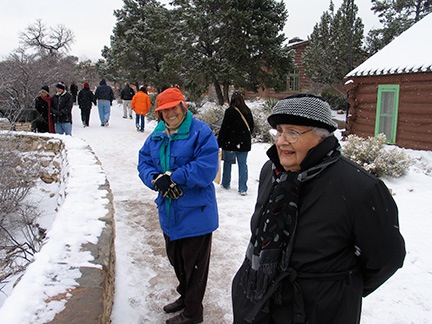
I’m ashamed to admit it, but I always wished that you were more like your friend Mildred: fun loving, independent, happy. I knew that her death would leave an empty space in your life and it made me so sad for you.
In the later years of my marriage to your son you became a source of friction between us. As you aged, you seemed to become more and more dependent on Mike to help you with the chores of life. Even after we moved to Arizona, you had him near you a full week (or more!) every month — he maintained a separate home there! Later, when he gave that up, he spent all of his vacation time going back to New York to visit you, using Vitec business as an excuse. You spoke on the phone multiple times each day — hell, he talked to you more than me!
Was I jealous? Perhaps. But also frustrated. I couldn’t understand why you needed him so much and why he was so willing to put our life together aside to accommodate you.
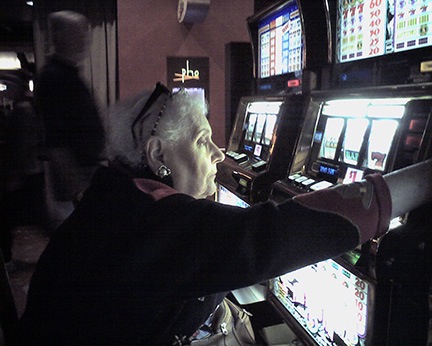
Do you remember that trip to Vegas? We flew up in my helicopter for an overnight stay at the Bellagio. I sent you a photo book to remember it and show your friends.
This all came to a head during your visit to Wickenburg in 2012. We’d arranged for a wonderful apartment for you in town. When Mike went to get you and Paul at the airport, I went to the store to buy groceries and other supplies. I stocked your fridge and cabinets with the kinds of food I thought you’d like, along with lots of fresh fruit and veggies. I bought flowers for your table. I wanted you to feel happy and welcome and at home in this place. After all, Mike had led me to believe that you were considering a move to Wickenburg and I wanted you to like the place we’d found for you.
I didn’t expect you to be at our home every evening, sitting at the table, playing cards with my husband. I didn’t expect everything we did for the duration of your two-month visit to include you. And I certainly didn’t expect you to laugh when I asked and tell me that you had no intention of moving to Wickenburg. I felt lied to, betrayed, manipulated — by your son. It should have warned me of things to come.
When Mike lost his job during that visit, I saw an opportunity for the two of us to get away for a few days in the RV before he started his next job, the dream job. A trip to Death Valley for the spring wildflowers. Some time away from home and the apartment. Some time to regroup and work out the tension that had formed between us since my return from Washington the previous fall. He said he wanted to go, but he delayed getting the plans together. He said he would tell you that we’d be gone for five days, but even the day before our planned departure you still didn’t know. And then he carelessly lost our friend’s dog in the desert and I snapped.
I was tired of being so far down on his list of priorities. I was frustrated with his inability to get his life together and make things happen. I was sick of listening to his excuses and feeling that he was hiding things from me. I was also tired of seeing how he feared you and your response to something that you might not like.
Yes, your son was afraid of you — as he was afraid of me. I’m sure he’s afraid of the woman who has taken our place, too: his mommy/girlfriend.
If only you knew how many times he lied to you — to “protect” you, he said. I realize now that he was lying to me, too.
I wonder how much stress you put on his relationship with that woman. I hope it was at least as much stress as you put on my relationship with him.
I’ll admit that if your son and I were still together, your passing would come as a relief to me. But now, estranged from your whole family by lies, betrayals, and misunderstandings, I feel only sadness and a sort of emptiness deep in my soul. Yes, we had our differences and you drove me nuts, but I respected you and your love for your children and your granddaughter. I respected your sacrifices for your husband, spending so many years making him a home. You did what you knew how to do and you poured your heart and soul into it. You did what you thought was right — even if it did have consequences you didn’t understand or even know about. I respected you for that.
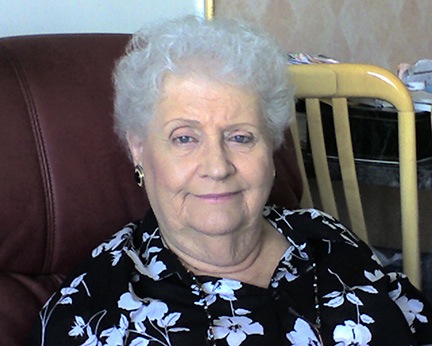
Julia Chilingerian, 1922 – 2013
I regret that I was unable to talk to you one last time. To explain what happened between me and your son. To ask you if you knew why he gave up a 29-year relationship with the woman he claimed to love as recently as your last birthday for a manipulative stranger who led him astray. To forgive you for driving that wedge between us, for contributing to the friction that made him grow to hate me.
This letter will have to do. If there is an afterworld — a heaven, perhaps — you’ll know the truth.
I’ll miss you, Julia, as I miss the life I had with your son — good and bad. Rest in peace. You deserve it.
With love,
Your daughter-in-law,
Maria





